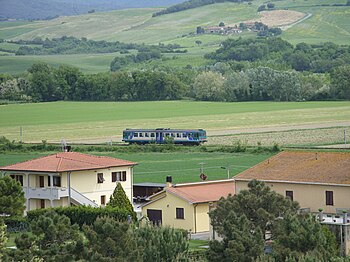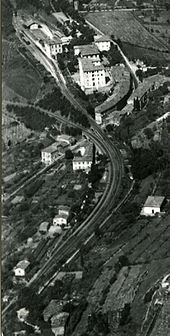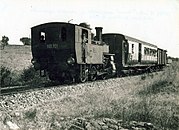Cecina – Volterra railway line
| Cecina-Volterra | |||||||||||||||||||||||||||||||||||||||||||||||||||||||||
|---|---|---|---|---|---|---|---|---|---|---|---|---|---|---|---|---|---|---|---|---|---|---|---|---|---|---|---|---|---|---|---|---|---|---|---|---|---|---|---|---|---|---|---|---|---|---|---|---|---|---|---|---|---|---|---|---|---|
|
Class ALn663 railcars at Casino di Terra
| |||||||||||||||||||||||||||||||||||||||||||||||||||||||||
|
Route profile: blue: adhesion sections, red: rack
| |||||||||||||||||||||||||||||||||||||||||||||||||||||||||
| Route length: | 37.5 km | ||||||||||||||||||||||||||||||||||||||||||||||||||||||||
| Gauge : | 1435 mm ( standard gauge ) | ||||||||||||||||||||||||||||||||||||||||||||||||||||||||
| Maximum slope : |
Adhesion 1912–1958: 30 ‰ rack 1912–1958: 100 ‰ |
||||||||||||||||||||||||||||||||||||||||||||||||||||||||
| Rack system : | 1912-1958: Strub | ||||||||||||||||||||||||||||||||||||||||||||||||||||||||
|
|||||||||||||||||||||||||||||||||||||||||||||||||||||||||
The Cecina – Volterra railway is a single-track railway line opened in 1863 from Cecina to Volterra- Saline-Pomarance (formerly Saline di Volterra) of the Ferrovie dello Stato Italiane (FS) in the Italian region of Tuscany . From 1912 to 1958 an extension of the route with mixed adhesion and cogwheel operation led from Saline di Volterra to the city of Volterra.
history

Construction of the Cecina – Saline di Volterra railway began in 1860, shortly after the rule of the Grand Duchy of Tuscany collapsed and a provisional Tuscan government took over. When the Cecina – Saline di Volterra railway was inaugurated on October 20, 1863 , Tuscany was already part of the Kingdom of Italy . The railway line operated as an adhesion railway was of particular importance for the various local mining and industrial companies. From 1872 to 1928, the open- cast lignite mine at Monterufoli was connected to the Casino di Terra station by a 17-kilometer track .
The city of Volterra , located on a ridge, was not directly accessible from the railway line. Thanks to the interest of Prince Piero Ginori Conti, a connection between the city and the Saline di Volterra became financially feasible. In the summer of 1909, construction work began on the 8,465 meter long section, of which 3,719 meters with a constant gradient of 100 ‰ were equipped with the Strub rack and pinion system . Immediately before Volterra, a hairpin was necessary to prevent a curve with a radius of less than 100 meters. The kilometer of the route started at Roma Termini station . The section was opened on September 15, 1912.
The Swiss Lokomotiv- und Maschinenfabrik (SLM) in Winterthur locomotives procured four three-axle locomotives with separate adhesion and gear drive systems in Winterthur for the transport of trains on the rack section . These machines, known as the 980 series , were able to carry a payload of 70 tons on a 100 ‰ gradient at a top speed of 15 km / h. The trains, which were initially made up of normal wagons, were re-hauled in Saline di Volterra and the adhesion locomotive coming from Cecina was replaced by a class 980 rack-and-pinion locomotive. From 1921 the trains between Saline and Volterra were made up of type CDUz or BCDUz cars, which were equipped with gear brakes, and passengers had to change trains in Saline. In order to prevent the wagons from unrolling, the trains were pushed on the way up. The locomotive was lined up between the saltworks and the hairpin on the valley side of the train. Because of the turn in the hairpin, the trains reached Volterra with the locomotive at the Zugspitze.
Traffic developed very well in the first few years. Alabaster , wood, coal and artificial fertilizers were mainly transported in freight traffic, while prisoner transports to the Medici fortress, which served as a state prison, were added to passenger traffic.
After the Second World War, the advent of road competition made the railways difficult. Between Saline and Volterra the travel time on the road was fifteen minutes compared to three quarters of an hour with the now outdated rack railway. In addition, the change in Saline was unattractive. On November 12, 1958, operations between Saline and Volterra were stopped, which then also reduced passenger traffic on the remaining section of the Cecina-Saline.
Mixed train on the rack section in 1938
business
The railway line is served by four pairs of regional trains on working days, freight traffic no longer takes place. The stations have been converted into stops , the train protection is carried out by driving in one-train operation .
literature
- C Four-cylinder composite gear and adhesion tank locomotive Group 980 of the Royal Ital. St.-B. In: Die Lokomotive , 1913, pp. 34–37 ( ANNO - AustriaN Newspapers Online )
- Neri Baldi, Stefano Maggi: Un futuro per Volterra. A future for Volterra. In: I Treni, No. 206, Verlag ETR, July / August 1999 (Italian)
- Francesco P. Bianchi: La questione ferroviaria di Volterra. The Volterra Railway Question. In: Rassegna Volterrana, year 56, Arti Grafiche Pacini Mariotti, 1980 (Italian)
- Adriano Betti Carboncini: La ferrovia di Volterra. The Volterra Railway. In: I Treni Oggi, No. 30, ETR Verlag, May / June 1983 (Italian)
- Adriano Betti Carboncini: La Maremmana. Storia della ferrovia Roma – Pisa dalle origini ai giorni nostri. La Maremmana. History of the Rome – Pisa railway from its beginnings to the present day. Calosci Publishing House, Cortona , 1998 (Italian)
- Pietro Lanino: La costruzione della linea in aderenza mista Saline-Volterra. The construction of the Saline – Volterra line with mixed adhesion and gear drive. In: Rivista Tecnica delle Ferrovie Italiane. Technical magazine of the Italian Railways. Volume 1, Volume 1, March 1912 (Italian)
- Albano Maccarini: La cremagliera di Volterra. The Volterra rack railway. In: AmicoTreno Volume 5, No. 1, Leonardo Periodici, January 1996 (Italian)
- Stefano Maggi: Ferrovia Cecina – Volterra. Il trasporto pubblico in un territorio isolato. Cecina-Volterra Railway. Public transportation in a remote area. Edizioni Nerbini, Florence 2011 (Italian)
- Roberto Riu: La ferrovia a cremagliera Saline-Volterra. The Saline – Volterra cog railway. Pisa Economica No. 4, 1997 (Italian)
- Roberto Riu. La ferrovia a cremagliera Saline – Volterra. The Saline – Volterra cog railway. In: Microstoria, No. 53, Nuova Toscana Editrice, 2007 (Italian)
- Linea Cecina – Volterra. Tronco Volterra (Saline) –Volterra (Città). Planimetria-profilo. Cecina – Volterra line. Section Volterra (Saline) –Volterra (city). Plan profile. Ferrovie dello Stato, Direzione Generale - Servizio Lavori, September 1919 (Italian)
- Fascicolo linea 96. Brochure line 143. Rete Ferroviaria Italiana (Italian)
- Ferrovia Saline di Volterra Pomarance - Volterra . On: Ferrovie abbandonate, accessed January 1, 2018 (Italian)
Web links
- Ferrovia Saline di Volterra Pomarance - Volterra. On: Ferrovie abbandonate, accessed on January 1, 2018, with images from the operating time and the present (Italian)
- Walking along old rail: The Saline-Volterra rack railway (English)







